Unit 3
Gear Trains
Q1) Explain simple gear train with neat sketch.
Ans.

Let  =speed of gear 1 in r.p.m
=speed of gear 1 in r.p.m
 =speed of Gear 2 in r.p.m.
=speed of Gear 2 in r.p.m.
 =number of teeth on gear 1 and
=number of teeth on gear 1 and
 = number of teeth on gear 2.
= number of teeth on gear 2.
Speed ratio=
Train value=
Let  = speed of driver in RPM
= speed of driver in RPM
 =speed of intermediate gear in RPM
=speed of intermediate gear in RPM
 = speed of driven or follower in r.p.m
= speed of driven or follower in r.p.m
 = number of teeth on driver
= number of teeth on driver
 = number of teeth on the intermediate gear
= number of teeth on the intermediate gear
 = number of teeth on driven or follower
= number of teeth on driven or follower



speed ratio =
Train value=
Q2) Explain compound gear train with neat sketch.
Ans.

Let  =speed of driving gear 1.
=speed of driving gear 1.
 = number of teeth on driving gear 1.
= number of teeth on driving gear 1.
 = speed of respective gears in RPM
= speed of respective gears in RPM
 = number of teeth on respective gears.
= number of teeth on respective gears.
Since gear 1 is in mesh with Gear 2, therefore, its speed ratio is

Similarly for Gear 3 and 4-speed ratio is

And for gears 5 and 6-speed ratio is

The speed ratio of the compound gear train is obtained by multiplying the equations 1 2 and 3

Speed ratio= 
Train value=
Q3) Explain reverted gear train with neat sketch.
Ans.
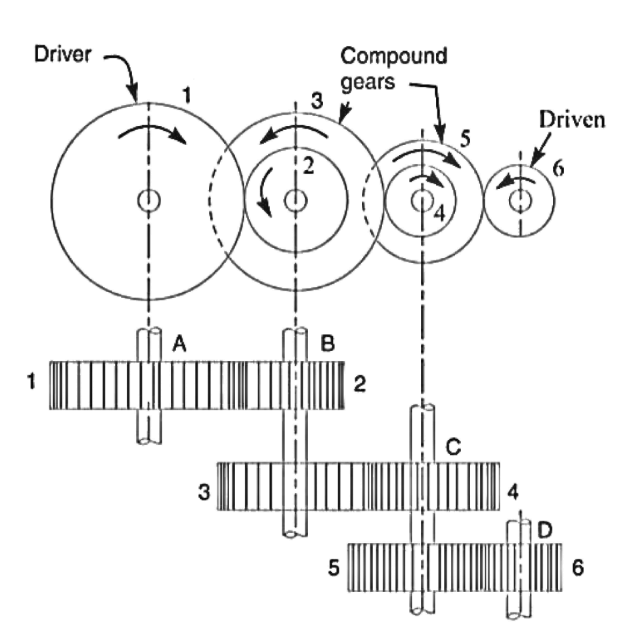
Let  =number of teeth on gear 1
=number of teeth on gear 1
 = pitch Circle radius of gear 1, and
= pitch Circle radius of gear 1, and
 = speed of gear 1 in RPM
= speed of gear 1 in RPM
Similarly,
 =number of teeth on respective gears,
=number of teeth on respective gears,
 = pitch Circle radius of respective gears and
= pitch Circle radius of respective gears and
 = speed of respective gears in RPM
= speed of respective gears in RPM
Since the distance between the centers of shafts of gear 1 and 2 as well as Gear 3 and 4 is the same common therefore
 …….. i
…….. i
also, the circular pitch or module of all the gear is assumed to be the same, therefore number of teeth on each gear is directly proportional to its circumference to the radius.
 ……….. ii
……….. ii
And  speed ratio
speed ratio
Or  ……….iii
……….iii
Q4) Explain epicyclic gear train with neat sketch.
Ans.


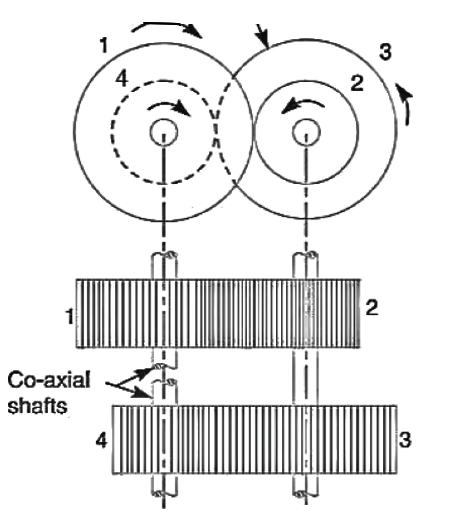
Q5) Explain the different methods of analyzing the epicyclic gear train.
Ans.
The following two methods may be used for finding out the velocity ratio of an epicyclic gear train.
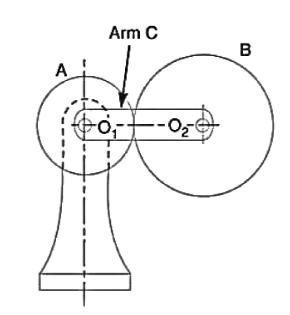
Let  = number of teeth on gear A, and
= number of teeth on gear A, and
 = number of teeth on gear B.
= number of teeth on gear B.



Step No. | Conditions of motion | Arm C | Gear A | Gear B |
1 | Arm fixed gear A rotates through plus one revolution | 0 | +1 |
|
2 | Arm fixed gear A rotates through +x revolutions | 0 | +x |
|
3 | Add +y revolutions to all elements | +y | +y | +y |
4 | Total motion | +y | x+y |
|
2. Algebraic method:-

And speed off the gear B relative to the arm C,

Since the gears A and B are meshing directly, therefore they will revolve in opposite directions.

Since the arm c is fixed, therefore its speed. 

If the gear A is fixed, then 

Q6) Explain sun & planetary gear train with neat sketch.
Ans.

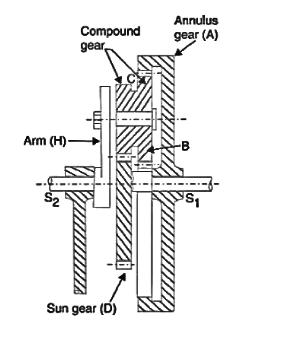
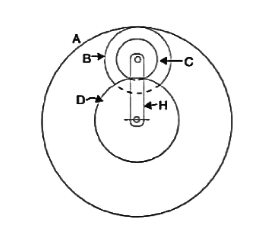


Step No. | Conditions of motion | Arm | Gear D | Compound gear B-C | Gear A |
1 | Arm fixed- gear D rotates through plus one revolution | 0 | +1 |
|
|
2 | Arm fixed -gear D rotates through +x revolutions | 0 | +x |
|
|
3 | Add +y revolutions to all elements | +y | +y | +y |
|
4 | Total motion | +y | x+y |
|
|
Q7) Explain compound epicyclic gear train with neat sketch.
Ans.
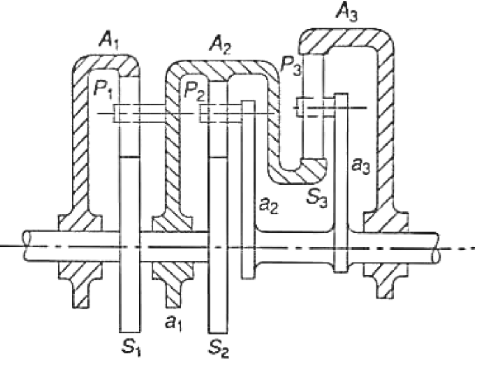








Speed of arm




As is integral with
is integral with 

Thus  can be known.
can be known.
In the same way,

 is integral with
is integral with 

So  can be calculated.
can be calculated.
Q8) Explain bevel epicyclic gear train with neat sketch.
Ans.
Humpage's speed reduction gear.
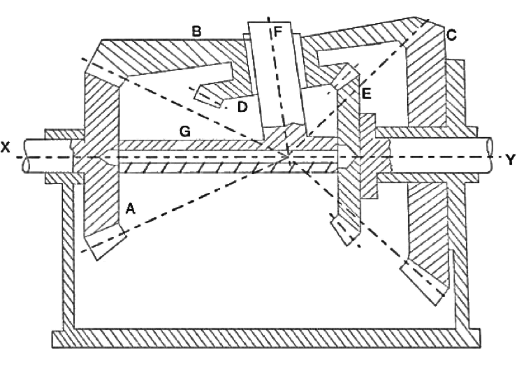
Q9) What are the different torques acts on the epicyclic gear train?
Ans.
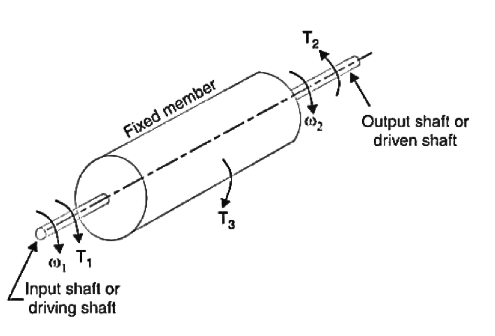
3. Input torque on the driving member
4. Output torque for resisting or load torque on the driving member.
5. Holding or breaking or fixing torque on the fixed member


Where  are the corresponding externally applied forces at radii
are the corresponding externally applied forces at radii 


But for a fixed member 

Q10) Differentiate between Gear train & gearbox.
Ans.
Gear train | Gearbox |
Gear train consists of many gears. | The gearbox consists of many gear trains. |
Only a single speed is available at last gear. | Different speeds can be available at last gear. |
The simple, compound, reverted & epicyclic gear trains are different types of gear trains. | Sliding mesh, constant mesh, synchromesh, and epicyclic are different types of gearboxes. |
Gear trains are used in lathe machines, clocks. | The gearbox is used in automobiles. |









